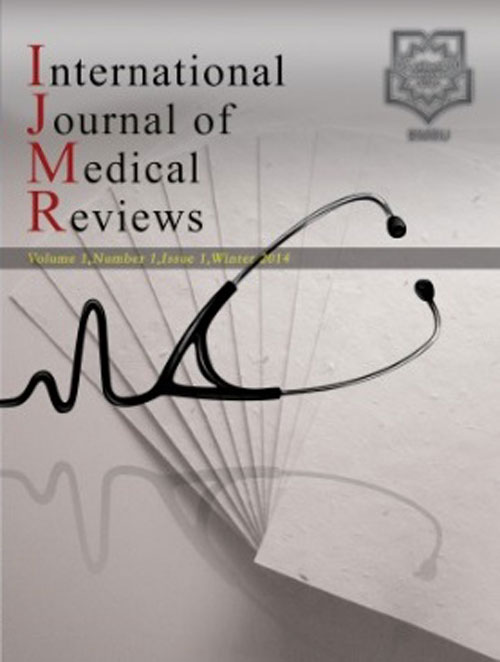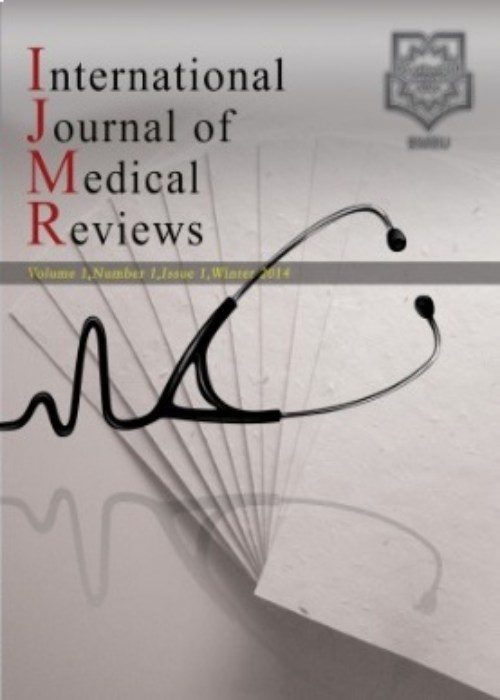فهرست مطالب

International Journal of Medical Reviews
Volume:7 Issue: 3, Summer 2020
- تاریخ انتشار: 1399/06/11
- تعداد عناوین: 7
-
-
Page 77
Among different sections of society, pregnant women are considered one of the most vulnerable groups to COVID-19 due to specific physiological changes in the body and the suppression of the immune system (4). About four months have passed since the onset of the disease, and although many studies are published daily on its various aspects, there is still not enough research and evidence to support the effects of COVID-19 on the consequences of pregnancy, but since the cause of the disease from the family of viruses that cause the two diseases, SARS and MERS, a look at the effect of these diseases on the consequences of pregnancy will lead to more attention to pregnant women at risk for COVID-19. Evidence suggests that pregnant women with SARS and MERS have the following adverse effects on their counterparts: spontaneous abortion, preterm delivery, premature rupture of membrane, preeclampsia, intrauterine growth retardation, Cesarean section increase, perinatal mortality and Increased hospitalization in neonatal intensive care unit (5). In the current situation, due to the recommendation of home quarantine and the concerns that pregnant women have about COVID-19 disease, they may be less likely to appear in Health care centers during pregnancy. Since COVID-19 has the potential to be at least similar to SARS and MERS, Therefore, it is recommended to reduce maternal mortality and the adverse consequences of pregnancy, Continuous telephone or online screening for COVID-19 was done by health providers in pregnant women and any suspicious cases should be seriously investigated.
Keywords: COVID-19, novel coronavirus infection, Pregnancy -
Pages 78-84Background
Nurses are vital in the management of patients for diagnostic imaging examinations. Some nurses work in radiology departments and others assist radiographers during mobile and theatre radiography. In recent years, some nurses working in the UK and Ireland are referring patients for radiological examinations, a role which was traditionally that of medical doctors. This work involves ionising radiation which is harmful to the human body. Therefore, it is essential that nurses understand the measures needed to protect patients, members of the public and themselves from ionising radiation. The aim of this study is to systematically review the awareness of nurses to radiation protection in medicine.
MethodsThis systematic review was conducted using PRISMA guidelines.The search was conducted in January 2020 in three databases: ScienceDirect, PubMed/MEDLINE and CINAHL, as well as hand searching of journals and internet. Data were extracted from all included research studies and analysed thematically.
ResultsTen primary research studies were identified, selected and included in this systematic review. Six themes were identified following data synthesis and analysis: sources of ionising radiation, benefits of ionising radiation in medicine, biological effects of ionising radiation to the human body, principles of radiation protection, control measures for external radiation exposure, populations most vulnerable to ionising radiation, and education and training in radiation protection. In general, this review found that nurses are not adequately aware of radiation protection.
CONCLUSIONThere is a need to integrate radiation protection into the nursing curriculum and to provide continuing professional development (CPD) to nurses.
Keywords: awareness, Nurse, Radiation, Radiation Protection -
Pages 85-92Background
Dental health considered the primary requisites of life and the WHO emphasis on continuous improvement during the 21st Century. Best knowledge about the factors affecting household dental demand is essential for formulating a detailed and comprehensive oral and dental health plan.
MethodsTherefore, to the best understanding of demand determinants, literature published in English and Persian languages retrieved with a systematic review using the PRISMA protocol. Final citation critically appraisal by CASP and PRISMA checklists, and eventually, factors affecting dental services demand present in a narrative synthesis.
ResultsAt all 2016 articles retrieved. One thousand seven hundred eighty-six articles excluded from the study, and out of the 230 articles, full texts of 16 articles selected, and their contents assessed. The main determinants of dental services demand to classify into three groups of demographic, classic, and complementary factors.
ConclusionIt is necessary to consider the predisposing, enabling, and need factors for estimating household dental demand function. Identifying and explaining the affecting factors of a household dental services makes it possible to obtain an accurate empirical estimation of the demand function and, can analyze the behavior of consumers by calculating the elasticities. Policymaker's attention to these factors will lead to the harmonization of providing dental services under the expectations of households.
Keywords: demand, dental services, Household, Systematic review -
Pages 93-97
Pyroptosis is a cell death mechanism that appears as an inflammatory form of cell death triggered by inflammasomes and disrupts a human protein encoded by the GSDMD gene in chromosome 8 (Gasdermin D) and by cytokine activation. Scientific facts have already indicated that the association between pyroptosis and cancer is extremely complicated, since pyroptosis´ effects on cancer cells can change depending on the affected tissues and genetic differences. For example, pyroptosis can inhibit tumor progress; however, as a pro-inflammatory process, it can create an appropriate microenvironment for tumor growth. Nevertheless, the literature in the field has recently addressed important cancer treatment perspectives enabled by this process. The aim of the current study is to address a new nanomedicine aspect associated with pyroptosis.
Keywords: Pyroptosis, cancer, in vivo, In vitro, nanomedicine -
Pages 98-101
Cholelithiasis is one of the most prevalent diseases in gastroenterology. There are many factors in cholelithiasis, such as genetic, lack of physical activity, obesity, dietary, age, and other comorbidities. Commonly, cholelithiasis occurs asymptomatically; however, Murphy’s sign is one of the most frequent pathognomonic findings in abdominal examination. Ultrasonography is known as the gold standard imaging examination in diagnosing cholelithiasis. The management of cholelithiasis can be divided into two categories, such as medical treatment and surgical treatment, which depends on the patient’s condition..
Keywords: gallstones, cholelithiasis, Adults, Ultrasonography, ursodeoxycholic acid, cholecystectomy -
Pages 102-107
Radiography involves the use of different imaging modalities for diagnostic and treatment of diseases and injuries. The undergraduate qualification in radiography focuses on general radiography and basic aspects of different diagnostic imaging modalities. At postgraduate level, the concentration is on training radiographers in specialised fields of diagnostic imaging, such as ultrasonography (US), image interpretation and reporting, computed tomography (CT), magnetic resonance imaging (MRI), nuclear medicine (NM), mammography, and radiation protection. The aim of this article is, therefore, to review the readiness of Zambia in establishing postgraduate training in specialised diagnostic imaging by examining its strengths, opportunities, weaknesses, threats and existing postgraduate courses provided abroad. The article recognises that the establishment of postgraduate courses would enable radiographers to specialise and obtain advanced knowledge and skills in areas of healthcare need and their interest. This would prepare them in taking up new, advanced roles and expanding their scope of practice. It is anticipated that this would improve the quality of diagnostic imaging services in Zambia
Keywords: Radiographer, Diagnostic Imaging, Postgraduate Education -
Pages 108-113IntroductionBecause some children have allergies to egg as an important food source, finding the right alternative is essential. To date, the interaction between other birds’ eggs and hen egg has not been investigated in Iran. Because of the common usage of eggs from birds other than hens in Iran, the present study aimed to compare hens’ eggs with the eggs of other birds.MethodsIn this case-control study, 70 children who referred to our allergy clinic were evaluated. In patients who had a history of egg allergy, SPT and specific IgE Ab analyses were done, and then an oral food challenge (OFC) was performed. Patients with egg allergy underwent skin prick tests with eggs from birds such as turkey, goose, duck, quail, partridge, and pigeon.ResultsFrom 40 patients with egg allergy, 8 patients passed the OFC. The greatest cross-reactions were seen in turkey and quail egg extracts. The least cross-reactions were reported in partridge and pigeon. Among patients who had negative SPT with partridge egg (N=3), one patient passed and two failed the OFC. Three of the patients who had negative pigeon SPT (N=5) passed the OFC with pigeon egg.ConclusionIn conclusion, turkey, goose, duck, and quail eggs cannot be used as an alternative to hen eggs; only partridge or pigeon eggs can be considered as a suitable alternative to hen eggs.Keywords: Hen Egg, Cross-Reaction, Egg Allergy


